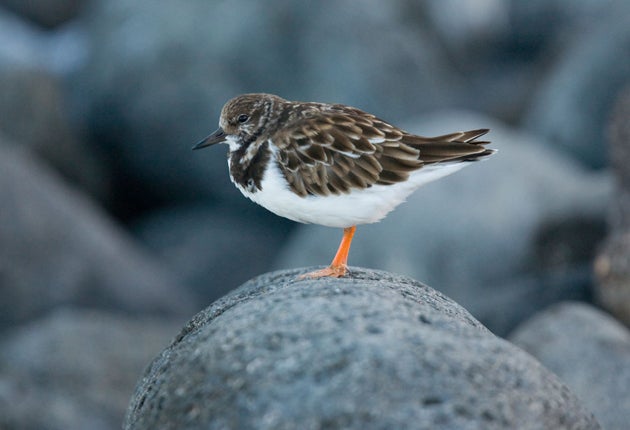Not such a short hop: the tiny bird that soared into the record books
British scientists' lightweight tags reveal the incredible journey of the world's smallest globetrotting high-flyer

At first glance, the ruddy turnstone looks barely strong enough to live up to its name let alone to migrate from one end of the world to the other.
It is little bigger than a song thrush and weighs in at somewhat less than a 250g stick of butter but the wading bird has a hard-won reputation as one of nature's greatest migrating animals.
Now a technological breakthrough by scientists at the British Antarctic Survey has at last allowed researchers to track the routes taken by the birds and to see exactly how far and fast they fly. Tiny light-sensitive tracking devices have shown ruddy turnstones can travel more than 16,700 miles (27,000 kilometres) as they migrate from Australia to the Arctic and back again.
It took four birds fitted with the devices just over six days, with several breaks for feeding, to fly the 4,700 miles from Flinders in South East Australia to Taiwan. One of them later managed a 3,850 mile leg in just four days and a further 3,100 mile leg in another four.
Analysis of the data provided by the tracking devices revealed that during the flight from Flinders to Taiwan and later from the Gilbert Islands to Australia the birds flew at an average speed of 31-34mph (50-55km/h). "A higher speed of 65 km/h was achieved during the flight from Alaska to Kiribati, indicating possible assistance by tail winds," added Ken Gosbell, of the Australasian Wader Studies Group (AWSG) which led the research.
Tracker devices have been used to monitor many species of animals but most have been far too heavy and cumbersome to load on to birds as small as the ruddy turnstone, Arenaria interpres. With the development of miniaturised light-sensitive geotracking devices, however, a whole new vista of avian research has been opened up.
"Unfortunately, the size of the satellite transmitters, and the batteries required to power them, precluded their use on smaller shorebirds like ruddy turnstones," said Dr Clive Minton from the AWSG. "However, a different technology using a 1 gram light-sensor geolocator has enabled researchers to track the 27,000 kilometre round trip of ruddy turnstones from Australia to their Arctic breeding grounds and back via China on their way north and via Kiribati [the Gilbert Islands] on their return trip across the Pacific.
"This now opens up the possibility of tracking the migration routes of shorebirds as yet virtually unknown."
The geotrackers created by scientists at BAS are extremely lightweight – the ones used on the turnstones are about 1 gram – which makes it possible to fit them to small birds without crippling them with extra weight.
Previously, light-sensitive trackers have been used on larger birds such as geese, albatross, penguins, and skuas, but further miniaturisation has enabled even small birds to be monitored. One device recently released by BAS weighs just 0.8g and another under development is just 0.6g.
They work by recording how long daylight lasts each day which, when analysed back in the lab, allows researchers to pinpoint which part of the world the birds were in on each day of the year.
Data provided by the trackers offers researchers the chance to gather much more detailed information on the birds' migration routes, including stop-offs for feeding, and their physical capabilities. Discoveries made by such studies help scientists build up a complete picture of the needs of birds and other animals which can be used to help conserve them.
For the study of ruddy turnstones from south east Australia, six were fitted at Flinders and another two were fitted at Carpenter Rocks. A year after being fitted scientists were able to retrive four devices, all at Flinders. The fate of the four other birds is unknown.
Tracker devices can be fitted on birds either by fixing them to a leg or by sticking them to the back. All the ruddy turnstone had them attached to legs because tests showed that after spending the Australasian summer fattening up to their maximum weight of about 190g they were "as round as tennis balls" and the backpack style wouldn't stay on.
Earlier this year, the results of a similar study on Arctic Terns fitted with miniaturised light-sensitive trackers revealed the long-distance birds took an 'S' shaped route on the northwards journey as they traveled 44,000 miles between the poles each year
Scientists have been so impressed by the lightweight tracking devices that they are fitting them on many more birds this year to learn more about migration routes. At least 60 ruddy turnstones, 30 greater sand plovers, Charadrius leschenaultii, and four sharp-tailed sandpipers, Calidris acuminata, are expected to be fitted with the geotrackers by the end of this month.
Flights of fancy: Record-breaking birds
Bartailed Godwit A female made the longest recorded non-stop flight of 7,145 miles from Alaska to New Zealand.
Peregrine Falcon With diving speeds in excess of 150mph as it swoops down on prey, it is the fastest bird in the world.
Sooty Shearwater Recorded the longest migration with an annual journey of 46,000 miles, and travelled up to 680 miles a day.
Arctic Tern Tracking devices recently showed a bird making an annual migration flight of 41,000 miles.
Greyheaded Albatross The fastest flight around the Southern Ocean was attributed to a male which flew 13,670 miles in 46 days.
Join our commenting forum
Join thought-provoking conversations, follow other Independent readers and see their replies
0Comments